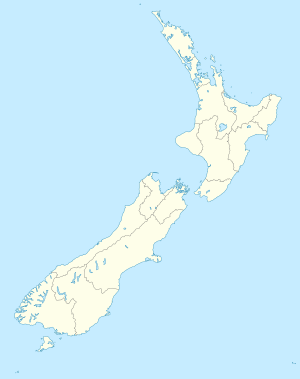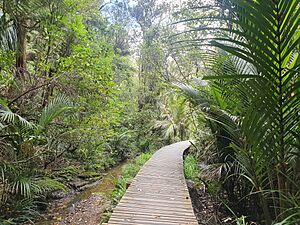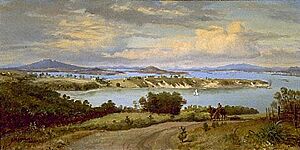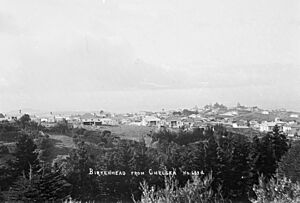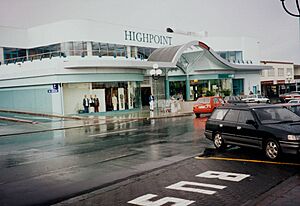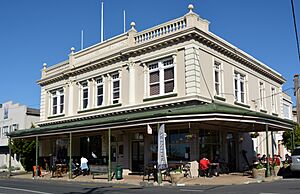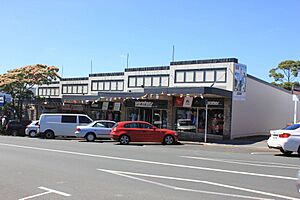Birkenhead, New Zealand facts for kids
Quick facts for kids
Birkenhead
|
|
|---|---|
|
Suburb
|
|
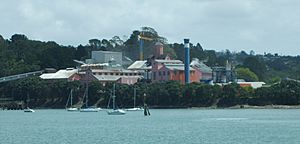
The sugar refinery, a local landmark.
|
|
| Country | New Zealand |
| Local authority | Auckland |
| Electoral ward | North Shore ward |
| Local board | Kaipātiki Local Board |
| Established | 1883 (Approx.) |
| Area | |
| • Land | 452 ha (1,117 acre) |
| Population
(June 2023)
|
|
| • Total | 10,530 |
| Postcode(s) |
0626
|
| Ferry terminal(s) | Birkenhead Ferry Terminal |
|
|
||
Birkenhead is a suburb in Auckland, New Zealand. It's on the North Shore of the Waitematā Harbour, about 4 kilometres northwest of Auckland City Centre. People have lived here for a very long time. Tāmaki Māori settled the area as far back as the 1300s.
A special fortified village called Te Matarae ō Mana was built here. It belonged to Te Kawerau ā Maki and watched over an important shark fishing spot. European settlers arrived in the late 1840s. By the late 1800s, Birkenhead was famous for its delicious strawberries.
In 1884, the Chelsea Sugar Refinery was built. This factory became a huge part of Birkenhead's economy. The area grew so much that it became one of Auckland's first boroughs in 1888. When the Auckland Harbour Bridge opened in 1959, Birkenhead changed from a quiet, country-like place to a busy suburb. It even became a city in 1978 before joining North Shore City in 1989.
Contents
Where Did the Name Birkenhead Come From?
The name Birkenhead first appeared around 1862. We don't know for sure how it got its name. It might be because the area looks a bit like Birkenhead in North West England. That town is across the River Mersey from Liverpool. Other places like this are in Adelaide and Sydney, Australia.
There's a story that a land developer named Samuel Cochrane chose the name. He supposedly named it after his hometown. But this story isn't true, as Cochrane was from London, not Liverpool. The first time Birkenhead was mentioned in newspapers was in 1863. These were advertisements for land sales by Samuel Cochrane.
What is Birkenhead's Landscape Like?
Birkenhead's land is mostly made of sandstone. This stone was formed on the seabed millions of years ago. Long ago, the North Shore was covered in thick forests. These forests had many kauri trees. Along the coast, you would see lots of pōhutukawa trees.
Some of these old kauri forests still exist today. You can find them in places like Kauri Park and Le Roys Bush. Other spots include Kauri Point Domain, Kauri Glen, and Eskdale Reserve.
Highbury is a smaller area within Birkenhead. It's known for its older shopping centre. This centre is where Birkenhead Avenue and Mokoia Road meet. Highbury was named after a house built by Thomas Forgham. His son-in-law, William Francis Hammond, chose the name. He remembered his parents' home in Highgate, London.
The highest point in Birkenhead is a hill in eastern Eskdale Reserve. It reaches about 98 metres above sea level. This spot is actually in the neighbouring suburb of Hillcrest.
Birkenhead's History
Māori Settlement and Life
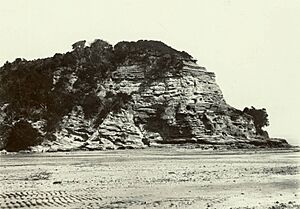
Māori people first settled in the Auckland Region around the 1200s or 1300s. The North Shore was home to Tāmaki Māori tribes. These included people from the Tainui canoe.
Boat Rock (Te Nihokiore, "The Rat's Tooth") is a special place. It's in the Waitematā Harbour, southwest of Birkenhead. A Te Arawa chief named Kahumatamomoe placed a sacred stone there. This stone gave the Waitematā Harbour its name, which means "The Waters of the Stone."
A warrior named Maki came to the Auckland area in the 1600s. He united many Tāmaki Māori tribes. These tribes became known as Te Kawerau ā Maki. After Maki died, his children settled different parts of his land. His daughter Kahu is the namesake of the North Shore. It is called Te Whenua Roa o Kahu, meaning "The Greater Lands of Kahu."
The land in Birkenhead wasn't great for farming. So, Māori settlements here focused on fishing. They also gathered food from the forests. The main village for Te Kawerau ā Maki was Te Mātārae ō Mana. This was a fortified village (pā) at Kauri Point. Another village, Rongohau, was below the cliffs at Kendall Bay.
Te Mātārae ō Mana was very important. It had a great view of the Waitematā Harbour. It was also close to a famous shark fishing spot. People from all over would come here in the summer to fish for sharks.
In the early 1800s, many Māori left the North Shore. This was due to wars during the Musket Wars. Around 1823, Te Mātārae ō Mana and Rongohau were attacked and destroyed. When Māori returned, they lived there again until the early 1840s. The shark fishery remained important for many years.
Other important Māori places in Birkenhead include Maunganui (an inland pā) and Ngutuwera (another inland pā). People would stay at Ngutuwera to catch kākā birds. The bays in the area also have traditional Māori names. These include Wararoa (Chelsea) and Onetaunga (Onetaunga and Soldiers Bay).
Early European Settlers Arrive
Birkenhead was part of a large area bought by the New Zealand government in 1841. Land buyers then purchased much of the isolated forests in 1843. The first permanent European settlers arrived in 1849.
One family, the de Jersey Gruts, tried to farm here in the 1850s. But the soil was poor, and farming was very hard. They left in 1865.
However, Henry James Hawkins started a fruit orchard in the 1850s. Even with the poor soil, he became a famous gardener. He won awards for his apples, plums, and especially strawberries. Growing fruit became a big business for Birkenhead from the 1860s. Two types of strawberries, Marguerite and Duke of Edinburgh, grew very well in the clay soil.
Birkenhead was planned as a town from 1863. People lived by farming and selling their strawberries. In 1879, William Francis Hammond bought land and built a large house. He helped promote Birkenhead and built a bridge to connect it to Northcote.
Roads were improved in the 1870s, which helped Birkenhead grow. A new wharf was built in 1882. This made it easier for fruit growers to send their produce to Auckland. In 1886, a fruit-growing group was formed.
In the 1880s, people called gum diggers came to Birkenhead. They searched for kauri gum. Locals didn't like them because they often damaged roads and farms.
Chelsea Sugar Refinery and Birkenhead Borough
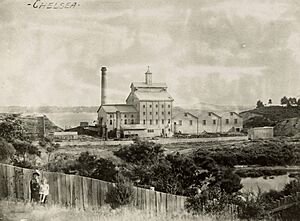
In 1881, a company called Colonial Sugar Refining Company chose Birkenhead for a new sugar factory. They picked this spot because it was close to Fiji, where sugarcane grew. Also, this part of Birkenhead had deep water for ships and fresh water from Duck Creek.
The factory opened in 1884. It quickly became a major employer. It's still the largest industrial site on the North Shore today. The sugar refinery caused Birkenhead's population to grow very fast. It helped the area become a busy town. A village was built next to the factory for the workers. This village was named Chelsea, after a town in England.
On April 12, 1888, Birkenhead became one of Auckland's first boroughs. A borough is like a small town with its own local government. Birkenhead was one of the largest boroughs in New Zealand. There were some disagreements between the town area of Highbury and the more rural Birkdale. Highbury wanted better footpaths, while Birkdale needed better roads for their farms.
In 1885, the Zion Hill Methodist Church was built. It became a very important place for social life. The church was also a strong supporter of the temperance movement. This movement was against selling alcohol. The church and the Chelsea Sugar Refinery were the two biggest influences on Birkenhead life around 1900.
Fruit Canning and Worker Rights
By the 1890s, Birkenhead was so famous for strawberries that people would visit just to pick them. Growers found it expensive to transport fresh fruit. So, many started canning and making jam. One company, Thompson's, began in Birkenhead in 1898. It later became Thompson & Hills, a big canning factory in Auckland.
Fruit growers faced problems like codling moths damaging apple and pear crops. By 1900, they started growing nectarines and plums instead. Commercial fruit growing slowly disappeared from Birkenhead by the 1910s. It just wasn't profitable anymore.
Around 1900, Birkenhead had three main areas: the suburban part, rural Birkdale, and Chelsea near the refinery. The factory gave steady jobs to many people. This helped farmers and orchardists when their crops weren't good. The ferry service brought new residents who worked in Auckland. The ferry even had a cafe feel, with music and a special cabin for smokers.
Workers at the Chelsea factory complained about long hours and unsafe conditions. In 1901, the Sugar Workers Union was formed. They fought for better safety and shorter work weeks. In 1910, the factory helped workers buy or build homes near the refinery.
In 1910, the Waiata Tropical Gardens opened. This was a popular tourist spot. It had many exotic plants and palm trees. It even encouraged people to plant palm trees all over Auckland.
Cinema, Wars, and Growth
In 1911, the Ancient Order of Foresters built a hall on Hinemoa Street. A year later, a theatre manager started showing films there. Birkenhead became the second suburb in Auckland to have a cinema. By the 1920s, Foresters Hall was a popular place for dances and movies.
Birkenhead grew, and by 1913, it had 12 stores. Plans for a new school were delayed until 1919 because of World War I. Many men and boys from Birkenhead served in the war. The community was also affected by the 1918 flu pandemic.
Highbury continued to develop with more shops and homes in the 1920s. In 1959, the Auckland Harbour Bridge opened. This made Birkenhead much closer to Auckland. The population grew rapidly.
In December 1926, Birkenhead got electricity. In 1934, the water system was greatly improved. Water was now pumped from Western Springs to Birkenhead. The pipe went under the Waitematā Harbour and was the longest of its kind then.
Farms in Birkenhead struggled in the 1920s because the soil was worn out. Farmers stopped growing strawberries and switched to pumpkins and tomatoes. During the Great Depression in the 1930s, many farms became unprofitable. The last commercial strawberry fields were removed in the 1940s.
Before World War II in 1938, the government built the Kauri Point Armament Depot in Birkenhead. Many residents served in the war. Women took on jobs usually done by men, including working at the sugar refinery and the armament depot. American troops arriving in Auckland also helped local flower growers.
Birkenhead Becomes a Modern Suburb
In the 1950s, Birkenhead was still quite rural. Only areas near the wharf felt like a suburb. But after the Auckland Harbour Bridge opened in 1959, everything changed quickly. Areas with harbour views became popular for new homes. The local council encouraged building affordable suburban houses.
Birkenhead's population and shops grew fast in the 1970s. This was helped by the Wairau Valley becoming an industrial area. Many Samoan and Urban Māori families moved to Birkenhead. Many of them worked in Wairau Valley or at the Sugar Refinery. When the population passed 20,000, Birkenhead became a city in 1978.
In the mid-1980s, plans were made for a new supermarket in Highbury. In 1989, Birkenhead became part of North Shore City. A new shopping centre, first called Strawberry Fields, opened in 1995. It's now known as Highbury Shopping Centre. By the 2000s, Birkenhead Town Centre had many restaurants.
In 2010, Birkenhead became part of the Auckland Council. It is now part of the Kaipātiki Local Board Area.
Birkenhead Today
Shopping and Amenities
Birkenhead has the Highbury Shopping Centre. It has over 600 parking spots and 25 shops, including a Countdown supermarket. The main shopping area is called the Birkenhead Town Centre.
- Birkenhead Ferry Terminal is at Birkenhead Point. You can catch a ferry from here. It also has a boat ramp for all tides.
- Le Roys Bush is a beautiful native bush reserve. It's a great place to explore nature.
Sports and Education
Birkenhead is home to Birkenhead United, a football (soccer) club. They play in the Lotto Sport Italia NRFL Division 1B. For the 2023 FIFA Women's World Cup, the Italy women's national football team trained here. This led to big upgrades for the clubrooms.
Birkenhead has two primary schools for years 1–6:
- Birkenhead School was started in 1919.
- Verran Primary School was founded in 1964.
Famous People from Birkenhead
- Clement Lindley Wragge: A meteorologist who started naming cyclones after people. He lived his last years in Birkenhead and planted many palm trees.
- Rudall Hayward: An early New Zealand filmmaker.
- Hone Tuwhare: A famous poet who was briefly a Birkenhead Borough Councillor.
- Hon Mike Rann: A former Premier of South Australia and ambassador. He lived in Birkenhead from 1964 to 1977.
- Edward Le Roy: A businessman who made tents. Le Roys Bush and Le Roy Terrace are named after him.
Images for kids
-
Kauri Point was the location of Te Mātārae ō Mana ("The Brow of Mana"), a Te Kawerau ā Maki pā overlooking the Waitematā Harbour and close to an important shark fishery


